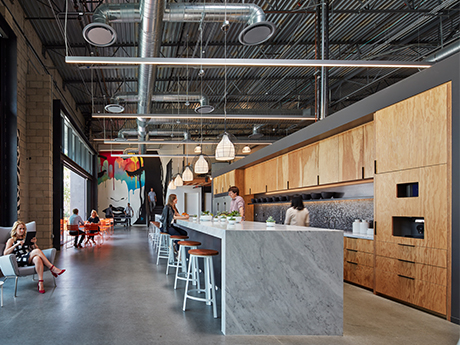— By Carina Mills and Maura Schafer —
In 2017, partner design firms RDC and Studio One Eleven (RDC-S111) relocated from a high-rise office to a former 25,000-square-foot Nordstrom Rack at 245 E. Third Street in downtown Long Beach, Calif. The store was located in a 1980s-era shopping center that had fallen into serious decline.
On the plus side, the location was consistent with Studio One Eleven’s mission of urban repair, allowing for a pedestrian-level interaction with the neighborhood, while strengthening the city fabric. Soon enough, the retail space was converted into a modern creative office that added 130 design professionals to the neighborhood’s daytime population.
This higher-use conversion occurred alongside other public and private investments that brought restaurants into the area. These included Ammatoli (a Los Angeles Times Top 100 restaurant), Beachwood Brewery, Rainbow Juices and Michael’s Pizzeria, among others. The adjacent Harvey Milk Park garnered grants for a reinvigoration by Studio One Eleven, and developers started working on housing development around the immediate neighborhood.
This move and project was not only a chance for RDC and Studio One Eleven to create urban impact, but to design an environment for staff that instills creativity, collaboration and wellness. The office achieved Green Business, LEED-Gold and Well Platinum certifications, boasting amenities like healthy snacks, exercise classes offered four days a week, bike racks and standing desks for all.
Accepting the New Hybrid Reality
It has been a difficult adjustment to realize that many staff don’t want to return to five days in the office post-pandemic. It’s been equally difficult to witness restaurants shuttering and fewer regular visitors to downtown Long Beach. Like many organizations, we surveyed our team and asked how many days a week people wanted to work from the office. As we watched the survey results come in, we asked ourselves: what does it mean if we’re not physically in this office five days a week? And how do we make a dynamic environment in the wake of COVID-19?
RDC-S111 has chosen to look for ways to incentivize a return to the office, rather than dictating a minimum attendance. We added a Community Engagement Manager to our team and created a Hybrid Office Committee. Paired with that, we continually work to create an environment where staff who are not mandated to come in, but instead choose to come in. We tried to make the office more like a private club: a place where membership is coveted, you can interact with talented designers and clients, take in a speaker series, attend a team happy hour, participate in a yoga class or simply escape to the quiet of your headset.
We also made our converted Long Beach office dog-friendly, as RDC-S111 knows our COVID puppies have become a fixture in our lives and a welcome visitor to anyone needing a break from work.
We also continue to invest in new virtual spaces to expand our collaboration methods and tactics. That way, when we work on projects together, the playing field is virtual for everyone. Our pin-up walls moved to visual workspace platform Miro, our page turns moved to Bluebeam (a construction software) sessions, and we have seen gains in productivity with the excitement of new collaboration strategies.
In 2023, we were invited to participate in the Los Angeles Design Festival as the downtown Long Beach hub. This birthed the idea of a Long Beach Design District, a collective for the city’s existing and growing design community.
A former Nordstrom Rack helped us reconnect with our community, while playing a part in revitalizing a local retail corridor. Other creative office firms may also find that spaces who once hosted retail tenants can have a positive impact on their culture, too.
Carina Mills, senior director of talent management and senior associate at RDC-S111, and 2024 president-elect for the California AIA, and Maura Schafer, chief marketing officer, RDC-S111


